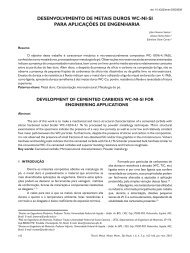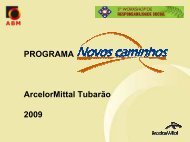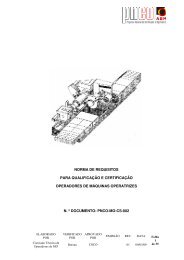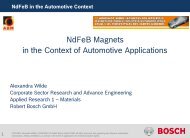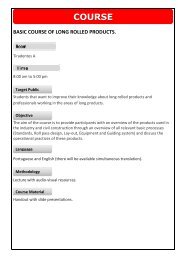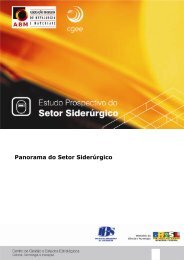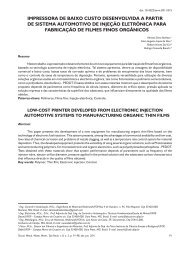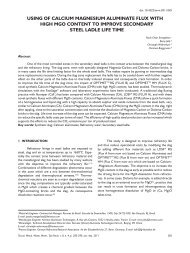ESTUDIO DEL ORIGEN DE INCLUSIONES EN EL ... - ABM
ESTUDIO DEL ORIGEN DE INCLUSIONES EN EL ... - ABM
ESTUDIO DEL ORIGEN DE INCLUSIONES EN EL ... - ABM
You also want an ePaper? Increase the reach of your titles
YUMPU automatically turns print PDFs into web optimized ePapers that Google loves.
Martín et al.4 CONCLUSIONESEn el presente trabajo, se estudia la influencia de laescoria de repartidor en la generación de inclusiones medianteel uso de trazadores (BaO). Los resultados de estos ensayosmostran que las inclusiones con Ba se hallaron en su mayoríaen los planchones afectados por el cambio de cuchara.También se observa que la densidad de estasinclusiones se incrementa según progresa la secuencia decoladas. Esto es debido a la acumulación de escoria enel repartidor seguido de una posible emulsión durante laapertura de la cuchara, generando inclusiones que puedenllegar al molde y quedar atrapadas en los planchones.Se adoptaron prácticas metalúrgicas para minimizareste efecto durante las operaciones diarias. La utilizaciónde barreras de argón en la flotación de inclusiones mostraimportantes reducciones de densidad inclusionaria en laspartículas grandes (>30 µm). Como consecuencia deestos resultados, el dispositivo se está utilizando cuando esnecesario producir acero con altos requisitos de limpieza.La colocación de una pieza anti-vortex en el repartidor,bajo las condiciones de proceso ensayadas, noproporcionó mejoras en la limpieza inclusionaria independientementedel tamaño de partículas.REFERÊNCIAS1 BYRNE, M.; CRAMB, A.; F<strong>EN</strong>ICLE, T. The source of exogenous inclusions in continuously cast: aluminum killedsteels. ISS Steelmaking Conference Proceedings, v. 68, p. 49-56, 1985.2 CRAMB, A.; BYRNE, M. Tundish slag entrainment at Bethlehem’s Burns Harbor (Indiana) slab caster. Iron andSteelmaker, v. 15, n. 12, p. 49-56, 1988.3 KASUNUMA, J. et al. Continuous casting of highly clean steel slab. ISS Steelmaking Conference Proceedings, v. 67,p. 17-19, 1984.4 PRABHU, N.; PINKOWSKI, J. Measuring cold rolled surface quality based on data collected at the caster. ISSSteelmaking Proceedings, v. 73, p. 491-5, 1990.5 <strong>EN</strong>GLISH, T. et al. The use of rare earth oxide tracers in the determination of inclusion sources and origins at BritishSteel, Scunthorpe Works, Clean Steel 4, v. 1, p. 262-82, 1992.6 NAM, S. et al. Improvement of steel cleanliness in ladle exchange period. ISS Steelmaking Proceedings, v. 78,p. 551-6, 1995.7 KIM, D. et al. Improvement of cleanness in melt of ferritic stainless steel by control of stirring power. ISS SteelmakingProceedings, v. 84, p. 343-55, 2001.8 FUHR, F. et al. Application of slag tracers to investigate the source of non-metallic inclusions. Ironmaking andSteelmaking, v. 34, n. 6, p. 463-70, 2007. http://dx.doi.org/10.1179/174328107X1746099 MARTÍN, A.; MARTÍN, M.; CICUTTI, C. Utilización de trazadores para determinar origen de macroinclusiones:informe 1º. Buenos Aires: Instituto Argentino de Siderurgia, 2008. (Reporte interno. PRO 08 058)10 MARTÍN, A. et al. Utilización de trazadores en la escoria de repartidor para evaluar el origen de macroinclusiones(seguimiento 3). Buenos Aires: Instituto Argentino de Siderurgia, 2009. (Reporte interno. PRO 09 025)11 RAY, S. et al. Modelling of tundish slag entrainment during ladle change. In: AISTECH CONFER<strong>EN</strong>CE, 2008,Pittsburgh. Proceedings… [S.l.: s.n.], 2008. v. 2.12 SOLORIO-DÍAZ, G. et al. Fluid dynamics of vortex formation in tundish operations: physical modeling. SteelResearch International, v. 78, n. 3, p. 248-53, 2007.13 SATISH KUMAR, D. et al. Forced flotation of inclusions in tundish. Ironmaking and Steelmaking, v. 36, n. 6,p. 470-5, 2009. http://dx.doi.org/10.1179/174328108X39384914 KITANO, Y. et al. Technology of reducing non-metallic inclusions in tundish in continuous casting. In: ISS <strong>EL</strong>ECTRICFURNACE CONFER<strong>EN</strong>CE, 56., 1988, New Orleans. Proceedings... S.n.t. p. 419-423.Recebido em: 19/09/2011Aceito em: 05/04/2012270 Tecnol. Metal. Mater. Miner., São Paulo, v. 9, n. 4, p. 265-270, out.-dez. 2012



